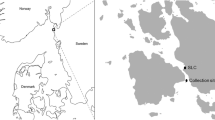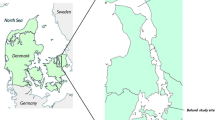Abstract
In intertidal sediments, burial and decomposition of macroalgal detritus can fuel the sediment of carbon (C) and nitrogen (N), which can be either promptly mineralised or assimilated to enter the food web. This study investigates the transfer of algal-derived C and N to the sediment and to the infauna feeding primarily on benthic diatoms. Thalli of Ulva spp. were 13C- and 15N-labelled in the mesocosm and frozen to create detritus. Thawed macroalgae were, then, buried in the sediment of an intertidal sand-flat forming a mosaic of small patches (50 × 50 cm2) enriched with the macroalgae interspersed with bare sediment. The area was dominated by Corophium volutator and Hydrobia ulvae. The uptake of 13C and 15N was measured in the residual macroalgae, in the sediment and in those animals. Decomposition of detritus was rapid and after 4 weeks the residual biomass was 3% the amount added. Algal-derived 13C and 15N were moved to the sediment. The total amount of 13C and 15N retained in the sediment after completing the decomposition was 3.4 ± 0.5% 13C and 2.7 ± 0.6% 15N the amount decomposed. During the first 2 weeks more N than C was assimilated (1.7% 13C and 13.5% 15N). During the remaining two weeks, N was released from the sediment, while there was little accumulation of C (+6.4 ± 2.0 % 13C and −7.7 ± 3.8% 15N). At the end of the decomposition, animals were 15N- and 13C-labelled. Considering the total accumulation of label in the sediment, they accounted for 3.5 ± 1.8% 13C and 25.8 ± 12.9 % 15N. Similarly, considering the mass of the heavy isotopes gained (13C) or lost (15N) during the remaining 2 weeks, the animals accounted for 4.7 ± 2.1% of the 13C in excess and for 18.6 ± 9.1% of the 15N loss. The transfer of C and N to the sediment and to the surface deposit-feeders can be a relevant mechanism to remove the excess of detritus from the sediment.



Similar content being viewed by others
References
Banta GT, Holmer M, Jensen MH, Kristensen E (1999) Effects of two polychaete worms, Nereis diversicolor and Arenicola marina on aerobic and anaerobic decomposition in a sandy marine sediment. Aq Micr Ecol 19:189–204
Bolam SG, Fernandez TF, Read P, Raffaelli D (2000) Effects of macroalgal mats on intertidal sandflats: an experimental study. J Exp Mar Biol Ecol 249:123–137
Buchsbaum R, Valiela I, Swain T, Dzierzeski M, Allen S (1991) Available and refractory nitrogen in detritus of coastal vascular plants and macroalgae. Mar Ecol Prog Ser 72:131–143
Cardoso PG, Pardal MA, Raffaelli D, Baeta A, Marques JC (2004) Macroinvertebrate response to different species of macroalgal mats and the role of disturbance history. J Exp Mar Biol Ecol 308:207–220
Castaldelli G, Welsh DT, Flachi G, Zucchini G, Colombo G, Rossi R, Fano EA (2003) Decomposition dynamics of the bloom forming macroalga Ulva rigida C Agardh determined using a C-14–carbon radio-tracer technique. Aq Bot 75:111–122
Cebrian J (2004) Role of first-order consumers in ecosystem carbon flow. Ecol Lett 7:232–240
Dizon RM, Yap HE (1999) Short-term responses of coral reef microphytobenthic communities to inorganic nutrient loading. Limnol Oceanogr 44(5):1259–1267
Fenchel T, King GM, Blackburn TH (1998) Bacterial biogeochemistry. The ecophysiology of mineral cycling. 2nd Edn. Academic, USA
Fontaine S, Bardoux G, Abbadie L, Mariotti A (2004) Carbon input to soil may decrease soil carbon content. Ecol Lett 7:314–320
Ford RB, Thrush SF Probert PK (1999) Macrobenthic colonisation of disturbances on an intertidal sandflat: the influence of season and buried algae. Mar Ecol Prog Ser 191:163–174
Goecker ME, Kall SE (2003) Grazing preferences of marine isopods and amphipods on three prominent algal species of the Baltic Sea. J Sea Res 50:309–314
Hagerthey SE, Defew EC, Paterson DM (2002) Influence of Corophium volutator and Hydrobia ulvae on intertidal benthic diatom assemblages under different nutrient and temperature regimes. Mar Ecol Prog Ser 245:47–59
Heip CHR, Goosen NK, Herman PMJ, Krokamp J, Middelburg JJ, Soetaert K (1995) Production and consumption of biological particles I temperate tidal estuaries. Oceanogr Mar Biol Annu Rev 33:1–149
Herman PMJ, Middelburg JJ, Van de Koppel JJ, Heip CHR (1999) Ecology of estuarine macrobenthos. Ad Ecol Res 29:195–240
Herman PMJ, Middelburg JJ, Widdows J, Lucas CH Heip CHR (2000) Stable isotopes as trophic tracers: combining field sampling and manipulative labelling of food resources for macrobenthos. Mar Ecol Prog Ser 204:79–92
Hull SC (1987) Macroalgal mats and species abundance: a field experiment. Estuar Coast Shelf Sci 25:519–532
Kristensen E, Mikkelsen OL (2003) Impact of the burrow-dwelling polychaete Nereis diversicolor on the degradation of fresh and aged macroalgal detritus in a coastal marine sediment. Mar Ecol Prog Ser 265:141–153
Levinton JS (1985) Complex interactions of a deposit feeder with its resources: roles of density, a competitor, and detrital addition in the growth an survival of the mudsnail Hydrobia totteni. Mar Ecol Prog Ser 22:31–40
Lopez GR, Levinton JS (1987) Ecology of deposit-feeding animals in marine sediments. Quart Rev Biol 62:235–260
Mann KH (1988) Production and use of detritus in various fresh-water, estuarine, and coastal marine ecosystems. Limnol Oceanogr 33:910–930
McGlathery KJ, Anderson IC, Tyler AC (2001) Magnitude and variability of benthic and pelagic metabolism in a temperate coastal lagoon. Mar Ecol Prog Ser 216:1–15
McGlathery KJ, Sundback K, Anderson IC (2004) The importance of primary producers for benthic nitrogen and phosphorous cycling. In: Nielsen SO, Banta GT, Pedersen MF (eds) Estuarine nutrient cycling: the influence of primary producers. Kluwer, Dordrecht
Middelburg JJ, Barranguet C, Boschker TS, Herman PMJ, Moens T, Heip CHR (2000) The fate of intertidal microphytobenthos carbon: an in situ 13C-labelling study. Limnol Oceanogr 45(6):1224–1234
Moore JC, Berlow EL, Coleman DC, Dong Q, Hastings A, Johnson NC, McCann KS, Melville K, Morin PJ, Nadelhoffer J, Rosemond AD, Post DM, Sabo JL, Scow KM, Vanni MJ, Wall DH (2004) Detritus, trophic dynamics and biodiversity. Ecol Lett 7:584–600
Nedergaard RI, Risgaard-Peterson N, Finster K (2002) The importance of sulfate reduction associated with Ulva lactuca thalli during decomposition: a mesocosm experiment. J Exp Mar Biol Ecol 275:15–29
Norkko A, Bonsdorff E (1996) Population responses of coastal zoobenthos to stress induced by drifting algal mats. Mar Ecol Prog Ser 140:141–151
Orvain F, Sauriau PG (2002) Environmental and behavioural factors affecting activity in the intertidal gastropod Hydrobia ulvae. J Exp Mar Biol Ecol 272:191–216
Peterson BJ, Fry B (1987) Stable isotopes in ecosystem studies. Annu Rev Ecol Syst 18:293–320
Polis GA, Anderson WB, Holt RD (1997) Toward an integration of landscape and food web ecology: the dynamics of spatially subsidized food webs. Annu Rev Ecol Syst 28:289–316
Post DM (2002) Using stable isotopes to estimate trophic position: models, methods and assumptions. Ecology 83:703–718
Raffaelli DG (2000) Interactions between macro-algal mats and invertebrates in the Ythan estuary, Aberdeenshire. Scotland Helgol Mar Res 54:71–79
Raffaelli DG, Limia J, Hull S, Pont S (1991) Interactions between the amphipod Corophium volutator and macroalgal mats on estuarine mudflats. J Mar Biol Assoc UK 71:899–908
Riera P, Hubas C (2003) Trophic ecology of nematodes from various microhabitats of the Roscoff Aber Bay (France): importance of stranded macroalgae evidenced through δ13C and δ15N. Mar Ecol Prog Ser 260:151–159
Risgaard-Petersen N (2003) Coupled nitrification-denitrification in autotrophic and heterotrophic estuarine sediments: On the influence of benthic microalgae. Limnol Oceanogr 48:93–105
Rossi F (2003) Short-term response of deposit-feeders to an increase of the nutritive value of the sediment through seasons in an intertidal mudflat (Western Mediterranean, Italy). J Exp Mar Ecol Biol 290:1–17
Rossi F (2006) Effect of buried algal mats on marine sediments: an experimental enrichment of Ulva spp. in intertidal sandflats. J Exp Mar Ecol Biol 332:84–95
Rossi F, Underwood AJ (2002) Small-scale disturbance and increased nutrients as influences on intertidal macrobenthic assemblages: experimental burial of wrack in different intertidal environments. Mar Ecol Prog Ser 241:29–39
Smith D, Hughes RG, Cox EJ (1996) Predation of epipelic diatoms by the amphipod Corophium volutator and the polychaete Nereis diversicolor. Mar Ecol Progr Ser 145:53–61
Sundback K, Miles A, Hulth S, Pihl L, Engstrom P, Selander E, Svenson A (2003) Importance of benthic nutrient regeneration during initiation of macroalgal blooms in shallow bays. Mar Ecol Prog Ser 246:115–126
Sundback K, McGlathery K (2005) Interactions between benthic Macroalgal and microalgal mats. In: Kristensen E, Haese RR, Kostka JE (eds) Interactions between Macro- and Microorganisms in Marine Sediments, AGU series “Coastal and estuarine studies”, vol 60., pp 2–29
Thrush SF (1986) The sublittoral macrobenthic communtiy structure of an irish sea-lough: effect of decomposing accumulatoins of seaweed. J Exp Mar Biol Ecol 96:199–212
Underwood AJ (1997) Experiments in ecology: their logical design and interpretation using analysis of variance. Cambridge University Press, UK
Webb AP, Eyre BD (2004a) The effect of natural populations of the burrowing and grazing soldier crab (Mictyris longicarpus) on sediment irrigation, benthic metabolism and nitrogen fluxes. J Exp Mar Ecol Biol 309:1–19
Webb AP, Eyre BD (2004b) Effect of natural populations of burrowing thalassinidean shrimp on sediment irrigation, benthic metabolism, nutrient fluxes and denitrification. Mar Ecol Prog Ser 268:205–220
Winer BJ, Brown DR, Michels KM (1991) Statistical principles in experimental design, 3rd edn. McGraw-Hill, New York
Acknowledgments
I am very grateful to P. M. J. Herman and J. J. Middelburg for their invaluable suggestions on the field experiment and on the early drafts of this manuscript. I also wish to thank G. Castaldelli who gave advises how to grow Ulva, B. Koutstaal, J. van Soelen and S. Como for helping in the field and P. van Breugel and C. Kleppe for doing the chemical analyses. P. Kamermans, RIKZ and T. Ysebaert were of great help in the first phase of this study. The comments of B. Gribsholt and of Prof. L. A. Levin contributed to improve an early version of this manuscript. This study is supported by a Marie-Curie grant to F. R. (MC Individual fellowship, Contract number EVK-CT−2002-50010 −30). This is the publication 3862 of Netherlands Institute of Ecology (NIOO-KNAW)
Author information
Authors and Affiliations
Corresponding author
Additional information
Communicated by R. Cattaneo-Vietti, Genova
Rights and permissions
About this article
Cite this article
Rossi, F. Recycle of buried macroalgal detritus in sediments: use of dual-labelling experiments in the field. Mar Biol 150, 1073–1081 (2007). https://doi.org/10.1007/s00227-006-0438-6
Received:
Accepted:
Published:
Issue Date:
DOI: https://doi.org/10.1007/s00227-006-0438-6




